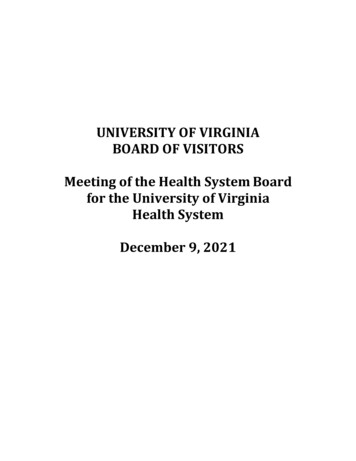
Transcription
REPORT SERIESReport #3 of 6How Does Racism in NursingShow Up in the Education Space?
Report #3 of 6How Does Racism in NursingShow Up in the Education Space?3Introduction4THEME: Historical8THEME: Pedagogy10THEME: Access13THEME: Climate and Culture15THEME: Progression18Conclusion20References
IntroductionSchools of nursing (SONs) are the front door to the nursing profession. Racial,structural, and institutional inequities that are embedded in nursing programs andschools have the most profound impact on the profession because of the expandedreach they have into the future of students who progress and those who fail, thenursing workforce, future nurse educators (NEs), and the health and well-being ofour nation. It is important that NEs learn about our racist history and work to createclimates and environments that are built on equity, human dignity, and equal serviceto all.It starts with leadership. Once students enter our SON and programs, academicleaders must ensure that faculty are trained about the history of racism in nursingand taught how to develop curricula and course content that are pedagogicallysound, are racially affirming, and promote an anti-racism ideology. Academic leaders,faculty, researchers, publishers, and social media platforms must evaluate all futurepublications, proposals, and communication to eliminate racist stereotyping ofdiverse populations. Our scholarship must be based on “biological markers” and notsocial constructs such as race, religion, gender, sexuality, etc. Nurse educators arecompensated for their services to prepare and produce future nurses, and there is noplace in the profession for structural and institutional barriers that block access andlimit students and faculty progressions. Both student and faculty need support tobe successful. Therefore, SON and university/college leaders will need to rethink howsuccess is measured in both spaces.Looking through a new lens, we invite you to review our work and provide criticalfeedback to inform this work and shape the future of nursing. It is our hope that youwill join us in advocating for real change. Nurses cannot chart a path toward healthequity until there is racial healing in the profession.3Report 3 of 6 How Does Racism in Nursing Show Up in the Education Space?
THEME: HistoricalGoal statement: Recognize the roots of racism in nursing education, climates andenvironments that are built on equity, human dignity, and equal service to all.Pre-19th CenturyTo recognize the metastatic nature of racism and how it presents in nursing today,one must painstakingly unearth the foundation that underlies the profession anddare to interrogate the racial caste system that shaped the discipline. In the early 17thcentury, racism emanated in the United States through a lens of white superioritythat promulgated a false doctrine and erroneous rhetoric that alleged the congenitalinferiority and worthlessness of individuals racially identified as Black (King, 1968). Race,a socially constructed marker, was sold as a biological construct that transcendedgenerations (National Human Genome Research Institute, 2018). Racism became thevehicle through which discriminatory ideas, policies, practices, guidelines, and rulescame together, were endorsed legally or de facto, and were driven by dominant voicesacross healthcare settings and the nursing discipline over multiple centuries (Hine,1989; Carnegie, 2000). While rooted in slavery, racism is not a binary construct thatexclusively encapsulates white dominance over Black disempowerment. Rather, racismcontinues to be operationalized by a subliminal and sometimes deliberate acceptanceand propagation of negative stereotypical messages about historically racialized groupsthat serve to delegitimize and reduce their full humanity, limit access, fuel oppression,normalize unfair treatment, and sustain racial inequities through racist policies. It isagainst this backdrop that the genesis of nursing came to be.The myth of “separate but equal” produced inequities regardless of where it wassituated or when it was espoused. It was during the Crimean War in 1854 that MarySeacole was denied an opportunity to join the team of nurses under the supervisionof Florence Nightingale (Seacole, 2005). Nevertheless, Seacole cared for wounded menafflicted with diseases, although separately and without the government sponsorshipafforded to Nightingale. Similarly, Jim Crow laws in the South denied access to highereducation and economic mobility. However, Historically Black Colleges and Universities(HBCUs) emerged, albeit grossly underfunded, to address the inequalities relatedto racism. Booker T. Washington established and served as president of TuskegeeUniversity in 1881. Tuskegee was the first HBCU and the first one to create a nursingprogram (Hine, 1989). Recognizing the need to create opportunities for AfricanAmericans and Blacks in the South and improve health care outcomes, HBCUs thathad nursing programs began to emerge between 1890 and 1930 and included DillardUniversity, Florida A&M, Hampton University, and Howard University (Hine, 1989).4Report 3 of 6 How Does Racism in Nursing Show Up in the Education Space?
THEME: HistoricalCONTINUEDRacism was not unique to the South. In 1890, Emma Reynolds applied to everynurse training institution in Chicago and was denied access (Hine, 1989). Her storywas not an anomaly (Carnegie, 2000). When the U.S. Supreme Court upheld theconstitutionality of a state’s Jim Crow law in Plessy v. Ferguson, in 1896, under thecloak of “separate but equal” systems, racial discrimination was affirmed in health caresystems and nursing education. In the United States, beliefs that fueled segregationcrossed state lines and prevented many students from accessing nursing. From 1890to 1925, racial segregation and discrimination occurred alongside “an elite cadre ofwhite nurse leaders” who gave “shape and guidance to the professionalization ofnursing” (Hine, 1989, p. 89). The professional organizations, journals, and special body ofscholarship created by white nurses were racially exclusive and reinforced the power ofdiscrimination and segregation (Hine, 1989; Carnegie, 2000).20th CenturyIn the first half of the 20th century, nursing was moving toward establishing formalizedhospital-based training for nurses (Hine, 1989). The centuries-long existence of Black,Indigenous, and Latinx nurses, midwives, and other healers was systematically erasedto make room for this new Victorian-era approach to nursing education, where nurseswere expected to be “literate” and meet a cadre of preferred characteristics. Thisemerging preference for white Eurocentric attributes influenced the developmentof “professional” nursing standards that continue to be used to discriminate againstracialized groups and perpetuate racism in nursing education (Baptiste et al., 2021;Hine, 1989; Niles & Drew, 2020; Theobald, 2020). By 1900, there were 432 nursingtraining schools, most of which were hospital-based programs. Hospitals andtraining programs for nurses remained largely segregated and rapidly overshadowedfreestanding nursing programs in the United States (Hine, 1989). Though Black,Indigenous, and Latinx women had historically been responsible for nursing care intheir communities, very few were admitted to nursing training schools (Hine, 1989;Moore & Drake, 2020; Theobald, 2020).During the period from 1900 to the 1950s, nursing education continued to evolvetoward a more standardized curriculum. In 1923, the Goldmark Report was published,stating that nursing education should occur in a university setting (Goldmark, 1923). Asnursing education moved into academic settings, the number of advanced educationprograms increased, and nurses of color continued to be excluded through the racialgatekeeping that was pervasive in the beginning half of the century (Niles & Drew,2020; Moore & Drake, 2021). Schools of nursing were not the only source of racialgatekeeping in nursing during this time. Nurses began to organize as a profession,with the first assembly of the Nurses Associated Alumnae of the United States and5Report 3 of 6 How Does Racism in Nursing Show Up in the Education Space?
THEME: HistoricalCONTINUEDCanada occurring in 1896. In 1911, the Nurses Associated Alumnae of the United Statesand Canada became the American Nurses Association (ANA). Once again, racializednurses were excluded from participation. In 1916, the ANA required that nurses jointhe organization through their state organizations, which denied membership toBlack nurses. Many states also prevented Black nurses from taking the examinationto become registered nurses (Moore & Drake, 2021). Groups that were racializedwere compelled to form their own professional nursing organizations. To address thespecific needs of Black nurses, the National Association of Colored Graduate Nurseswas formed in 1906 (Moore & Drake, 2021), and in 1916, the Association of RegisteredNurses of Porto Rico was formed (Walsh, 2018).In the 1950s and 1960s, a series of legal changes ended legal support for racialdiscrimination. In 1954, the U.S. Supreme Court ruled in Brown v. Board of Educationthat in the field of public education the doctrine of “separate but equal has no place”(Cornell Law School, 2020). Brown highlighted the nation’s racial caste system andset the stage for passage of civil rights legislation (Rothstein, 2014). As a result, dejure racial exclusion in historically white nursing institutions and organizations, whichendured through the 1960s (Lewenson & Graham-Perel, 2020), eventually ended. In1951, the National Association of Colored Graduate Nurses dissolved to integrate intothe ANA (Staupers, 1961). Passage of the Immigration and Nationality Act in 1965 endedlegal preference for immigrants from northwestern Europe (Masselink & Jones, 2014).Similarly, the ANA-sponsored Exchange Visitor Program, which had brought primarilyEuropean nurses to the United States before 1959, expanded to include nurses fromother countries, particularly from the former U.S. colony the Philippines (Choy, 2003).Although legal changes eventually had a significant impact on de jure racialdiscrimination, they had no power to abolish racist ideology in nursing and healthcare. Acceptance of scientific racism (beliefs in biological inferiority) contributed tonurses’ historic participation in the violation of racialized people’s human rights, suchas occurred in the Tuskegee Experiment (Crenner, 2012) and the forced sterilization ofthousands of racialized women in the 1960s and 1970s, and hundreds in the 2000s(Alonso, n.d.; Kardish, 2014). At the same time, scientific racism in nursing curricula andtextbooks prepared a nursing workforce to deliver discriminatory care (Byrne, 2001;Jaschik, 2017), reinforcing the status quo of medical apartheid in America (Garber, 2020;Newkirk, 2016; Smedley et al., 2003). De facto racial exclusion in nursing organizationsand mass human suffering caused by health injustice led to the formation ofprofessional associations to represent the voices of racialized nurses and theircommunities, including Chi Eta Phi Sorority Inc., a professional nursing organization in1932, the National Black Nurses Association (NBNA) in 1971, the National Association6Report 3 of 6 How Does Racism in Nursing Show Up in the Education Space?
THEME: HistoricalCONTINUEDof Hispanic Nurses (NAHN) in 1975 (NBNA n.d.; NAHN, n.d.), the Philippine NursesAssociation of America Inc. (PNAA) in 1979, the Asian American Pacific IslanderNurses Association (AAPINA) in 1992, and NANAINA in 1993 (which unites AmericanIndian/Alaska Native nurses and those who care for AN/AI people). Due to theongoing lack of diversity, support, and progression in nursing, in 1998 the NationalCoalition of Ethnic Minority Nurse Associations (NCEMNA) was founded to providea unified voice and force advocating for equity and justice in nursing and healthcare for ethnic minority populations. NCEMNA consists of five national ethnic nurseassociations: AAPINA, NANAINA, NAHN, NBNA, and PNAA.In the post-civil rights era, nursing education deployed policies that failed toreaddress its white supremacist foundations, resulting in reproduction of the precivil rights racial hierarchy. These seemingly race-neutral approaches obscured howwhite supremacist power relations cultivated inequality and oppression, enablingcontinuation of the status quo (Koschmann, Jeffers & Heidari, 2020; Jones, 2014).Examples include accreditation standards for nursing programs that failed tomandate equity (Hassouneh, 2018) and criteria for selection of National League forNursing Centers for Nursing Excellence that disregarded the need for anti-racistchange to achieve excellence. Similarly, the American Association of Colleges ofNursing (1997) has historically expressed support for diversity, equity, and inclusion(DEI) without engaging in the substantive anti-racist policy change efforts neededto create equal outcomes across groups. Thus, the construction of standards foreducation and of problems and their solutions by nursing educational institutionsand organizations obscured the operations of white supremacy while maintainingthe status quo of racial hierarchy in the profession.Nursing’s most recent history in the 21st century reveals some progress in changingthe predominantly white female leadership of the American Nurses Associationand other organizations. Of the first 35 ANA presidents, two were Black women:Dr. Barbara Nichols, elected in 1978, and Dr. Beverly Malone, elected in 1996 (Waite& Nardi, 2019). The election of Dr. Ernest Grant heralded the election of the firstBlack male president of the ANA, in 2014. He is currently serving his second term.However, at the state level, many of the ANA’s affiliate chapters have yet to elect anurse of color as president.7Report 3 of 6 How Does Racism in Nursing Show Up in the Education Space?
THEME: PedagogyNursing curricula and pedagogy have historically centered on the experiences ofpeople who are white-identifying and failed to ensure that content and methodsfor teaching are racially affirming, promote an anti-racism ideology, and mitigateanti-Blackness. This is evident in the pedagogical approach used to addresscultural competency, where a variety of races and ethnicities are discussed innursing textbooks and peer-reviewed journals. It is common to see stereotypesbeing taught through patient-provider scenarios, case studies, and simulations,and in the clinical setting.Nursing textbooks are commonly written without references to or inputfrom highly skilled scholars from minoritized groups. The omission of diverseperspectives and lived experience results in educational materials that perpetuatestereotypes and nonscientific, biased beliefs about Black people. The use of raceas it relates to medical diagnoses and treatment reinforces disproved notionsabout being Black or of African descent as a biological construct and contributesto ongoing racial disparities in health care (Bach, 2003). In fact, race is aninsufficient proxy for genetic ancestry, and science has demonstrated that race isa social category with no basis in biology (Lee, 2009).Despite the significant efforts to analyze the interlocking systems of inequitableaccess and discrimination in healthcare, nursing education tends not to includean anti-racism pedagogy in its curricula (Hassouneh, 2006). Nurse educatorsshould become proficient in and knowledgeable about social determinants ofhealth that are structurally, institutionally, and politically based as they preparethe future nursing workforce to provide culturally informed, congruent, and safecare for an increasingly diverse population.In addition, educators play a fundamental role in the academic success ofstudents and their ability to operationalize the profession’s value of social justice.Equity pedagogy is one approach to teaching and learning that supports theacademic achievement of all students. According to Banks (2006), “an equitypedagogy exists when teachers modify their teaching in ways that will facilitatethe academic achievement of students from diverse racial, cultural, gender,and social-class groups” (p. 18). Effective educators learn to utilize a range ofpedagogical strategies to meet the needs of a range of learners. Three examplesthat support the three domains of learning – cognitive, socio-emotional, and skills8Report 3 of 6 How Does Racism in Nursing Show Up in the Education Space?
THEME: PedagogyCONTINUEDand behaviors (Bloom & Krathwohl, 1956) – are (1) cooperative strategies ratherthan competitive strategies, to help students develop positive racial attitudes;(2) narrative pedagogy, which allows students to build on lived experiencesand supports relevance; and (3) culturally responsive teaching, which is “anumbrella term for pedagogies that prepare students to support social justice inand beyond the classroom” (Day & Beard, 2019, p. 279).Recommendations1. Develop programmatic outcomes for DEI and anti-racism.2. Assess curriculum for DEI, and revise. Consider policy modification.3. Assess educational resources for bias, especially textbooks.4. Assess for, develop, and ensure access to DEI educational resources –provide supplemental DEI educational resources as needed.9Report 3 of 6 How Does Racism in Nursing Show Up in the Education Space?
THEME: AccessGoal: To promote an equitable and inclusive academic environment (culture andclimate); students, staff, faculty, and administrators need access to people, resources,and opportunities to make a meaningful impact and drive optimal success.To promote an equitable and inclusive academic environment (culture and climate)where students, faculty, staff, and administrators are successful, each group needsaccess to people, resources, and opportunities. Within the academy, these groups havea synergistic relationship, meaning that the successes or challenges of one influencethe other, as well as the overall mission of an institution of higher learning. Althoughthey work together, each is discussed separately in terms of tools for success: people,resources, and opportunities.StudentsTo support BIPOC (Black, Indigenous, and people of color) nursing students, we mustset a standard that cultivates an environment of equitable and inclusive excellencealong with purposeful development of resources that foster the success of all students(Williams, 2020). Nursing schools must be intentional and committed to cultivatingan equitable and inclusive environment that affords students access to culturallyproficient faculty, staff, and opportunities to achieve superior academic outcomes,reinforced by anti-racist policies and pedagogies. There should be access andopportunities for students to engage with nursing faculty with diverse experiencesand role preparation such as nurse researcher and nurse executive/leader. BIPOCnursing students should also be provided with a sustainable and comprehensive safetynet including elements such as mentoring, early access to financial support, currenttechnology, mental wellness practitioners, healthy food, and safe and affordable on/off-campus housing. Access to nursing education should be financially accessible.Holistic admissions should be considered a successful strategy for developing adiverse student population with measurable diversity outcomes for students, staff, andfaculty. On the national level, nursing education accrediting bodies should implementstandards requiring holistic admissions review of all nursing programs with measurablediversity outcomes for students, staff, and faculty. Unlike other health professioneducation organizations, there are no nursing education accrediting bodies thatcurrently require this.10Report 3 of 6 How Does Racism in Nursing Show Up in the Education Space?
THEME: AccessCONTINUEDStaffStaff provide the support and infrastructure for members of the academiccommunity when it comes to equitable and inclusive excellence. Staff are vitalfront-line personnel that facilitate the advancement of the academy’s mission.For example, staff may be the first resource for students applying to nursingschool or remaining in a program because they may be advising students.Historically, we know the discordance arising from the interactions of culturallyinept staff and nursing faculty with BIPOC nursing students. Williams andcolleagues (2005) describe an equitable and inclusive excellence scorecardthat includes campus climate, with competent staff willing to help set thetone of the culture, commitment, and communication through the academicenvironment that students must navigate. Just as in other parts of theacademy, staff should be empowered to bring their whole selves to work, withopportunities for success. Staff success includes access to people, resources,and opportunities to make a meaningful contribution to inclusive excellence.FacultyBIPOC nursing faculty members face unique challenges compared to whitenursing faculty members. Therefore, an evidence-based, strategic supportplan is needed to move these faculty toward success (“Three Strategies toSupport Minority Faculty,” 2018). The plan includes access to people, resources,and opportunities. BIPOC faculty need access to collaboration opportunitieswith other faculty members who share the same ethnicity and culture. Theserelationships provide an accepting space for faculty to share experiences anddecrease feelings of social isolation while enhancing a sense of belonging.Bidirectional conversations between BIPOC faculty can help these educatorsexpress their experiences with microaggressions and bias in the workplace(“Three Strategies to Support Minority Faculty,” 2018). Access to senior-levelminoritized faculty and allies to promote faculty development and exposureto resources is crucial for success in the academy as teachers, scholars, andservant leaders.11Report 3 of 6 How Does Racism in Nursing Show Up in the Education Space?
THEME: AccessCONTINUEDAdministratorsExecutive leadership is critical to ensuring racism is addressed within theacademy. Williams and colleagues (2005) convey that administrators are mostimportant to cultivating and driving organizational change in the academy.They set the tone for communicating the vision, building capacity, andattracting and allocating resources to make ensure inclusivity. Depending ontheir role, administrators have significant responsibility in supporting academicinclusive excellence because they often control the necessary resources forstudent, faculty, and staff success. Not unlike other workplaces, academicadministrators set the tone for the culture and climate of an organization.The optimal culture would embrace, expect, and tolerate nothing less thanan inclusive environment for all stakeholders. To access people, resources,and opportunities for themselves and stakeholders, Kalargyrou and Woods(2009) stated that administrators need communication, diplomacy, and humanresources skills to develop collaborative and collegial relationships amongstaff and faculty. Executive leadership should be accountable for strategicallyrooting out racism in the academy, ensuring that there is equity and rewardsystems throughout.SummaryWith access to people, resources, and opportunities, individuals can contributeto the academy’s success while also experiencing a sense of value andbelonging. All stakeholders in an inclusive academy will contribute to andexpect a culture that embraces the importance of communication, diplomacy,empathy, humility, and respect.12Report 3 of 6 How Does Racism in Nursing Show Up in the Education Space?
THEME: Climate and CultureAs early as pre-school, distinct variabilities occur in school performance betweenminoritized groups and their peers (Voight, 2013). Almost half of all college studentswho enter a four-year postsecondary institution will fail to complete a bachelor’sdegree within six years of entering higher education (U.S. Department of Education,2012). In addition, BIPOC nursing students face substantial racial and ethnic disparitiesin college persistence and degree attainment.Climate and culture are concepts that help to describe the internal environments oforganizations and institutions. Culture refers to the deeply embedded patterns oforganizational behavior and the shared values, assumptions, and beliefs that membershave about their organization or its work. Climate is generally thought to focus onpatterns of behavior or formal activities in an institution that can be observed directlyand objectively. Examples include but are not limited to certain practices, policies,procedures, and characteristics. Climate is often related to governance and decisionpatterns, teaching and learning processes, participant behaviors, effort and interactionpatterns, and work patterns. Therefore, climate is considered to change more rapidlycompared to culture.Nora and Cabrera (1996) conducted a quantitative analysis of 831 students at a singlepredominantly white institution and found that students of color reported morenegative campus climates, higher levels of discrimination by faculty, and greaterinsensitivity in the classroom than their white peers. These are common negativebehaviors experienced by BIPOC nursing students enrolled at predominantly whiteacademic institutions. Developing diverse, equitable, inclusive, and accessibleenvironments where there is a collective sense of belonging and all individuals thriveand do their best work is critical to achieving academic nursing’s goals related todiversity, equity, and inclusion. When students feel valued, respected, and welcomedby their classmates and peers, they report experiencing a stronger bond to thegreater campus community. In this environment, students feel safe enough to shareexperiences, engage in thoughtful discussions, and offer support to others. Peers canalso help buffer the effects of a negative classroom relationship with a faculty member(Sidelinger et al., 2011).By developing a better understanding of how learning environments are impactingstudent success, educators can be equipped with valuable information to initiatechange, target areas of growth, and, most important, improve student outcomes.Hence, the examination of climate and culture is a key element in mitigating racism innursing education.13Report 3 of 6 How Does Racism in Nursing Show Up in the Education Space?
THEME: Climate and CultureCONTINUEDRecommendations to Build Inclusive Learning EnvironmentsThe National Academies of Sciences, Engineering, and Medicine (2021)recommends the following:1. Assess all organizational policies for diversity, equity, and inclusion bestpractices.2. Build an organizational anti-racist climate by routinely assessing theperceived racial climate as well as the cultural competence of faculty,staff, and students, and promote cultural competence of faculty, staff,and students. Assess student bias against faculty of color.3. Provide anti-racism training resources and create open and safe spacesfor action-oriented conversations.4. Build the infrastructure and allocate resources to supportunderrepresented and disadvantaged students, faculty, and staff. Anexample of structural resources is the existence of departmental groupsand clubs that are inclusive of people of color. These groups couldinclude faculty, staff, and students.14Report 3 of 6 How Does Racism in Nursing Show Up in the Education Space?
THEME: ProgressionRelated goal: 1. Advocate for equity in educational outcomes for racially minoritizedstudents in access, retention, and degree completion. (Student Focused)Related goal: 2. Ensure equitable structures and opportunities that foster pathwaysto increase the recruitment, retention, and progression of faculty of color andleaders in schools of nursing. (Faculty and Administrator Focused)OverviewEnsuring student, faculty, and administrator progression requires understandingof systemic patterns of disparity in order to address and eliminate barriers andremove participation gaps as part of an intentional strategy to improve studentprogression, faculty progression, and administrator progression (AccreditationBoard for Engineering and Technology, 2021). Intentional restructuring of academicenvironments that focuses on transparent policies, processes, and resources providesequitable access to resources that empower students, faculty, and administrators tobe successful in their progression pathways. To mitigate systemic racism embedded innursing education, the work group focused on systems, processes, and resources thatcan support students’ progression through their programs of study. Likewise, facultyand administrator progression can be supported by the implementation of systems,processes, and resources for role transition and role development.Operational Definitions for Progression1. Student progression is the pathway to degree or certificate completion fromthe point of admission through program completion. Student progressionencompasses retention and focuses on how students proceed throughprograms of study. Student progression includes systems, processes, andresources that assist students through their programs of study.2. Faculty progression is the pathway to role acquisition and includes systems,processes, and resources that support faculty success for transition in thefaculty role. Faculty progression starts on the first day of employment andproceeds throughout the employment period.3. Administrator progression is the pathway to role acquisition and includessystems, processes, and resources that support administrator success fortransition in the administrative role. Administrator progression starts on the firstday of employment and proceeds throughout the employment period.15Report 3 of 6 How Does Racism in Nursing Show Up in the Education Space?
THEME: ProgressionCONTINUEDResourcesResources to s
University, Florida A&M, Hampton University, and Howard University (Hine, 1989). Racism was not unique to the South. In 1890, Emma Reynolds applied to every . nursing education moved into academic settings, the number of advanced education programs increased, and nurses of color continued to be excluded through the racial











